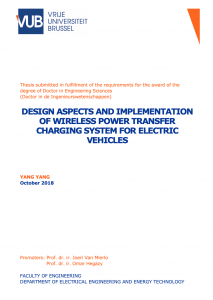
Nowadays, there is a growing interest in wireless charging systems for the future green vehicles due to their advantages such as safety, convenience and interoperable systems. As an energy interface between a vehicle and the grid, the bidirectional converter plays a crucial role in their interaction. For this purpose, design approach and control strategy have a significant impact on the performance of the wireless power transfer system (WPT) in electric vehicle powertrains in terms of efficiency, charging power, charging modes (i.e. G2V and V2G) and charging time, etc.
This PhD thesis presents a comparative study of different topologies, in order to achieve the maximum efficiency of power transfer for WPT system. The proper compensator for WPT system at the resonant frequency has been designed and optimized in terms of topology and output power. In addition, in the context of this dissertation, a new optimization methodology for the series-series (SS) topology of WPT for electric vehicles has been developed to optimize coupling coefficient and system efficiency in terms of the inner dimension and number of turns of the primary and secondary coils.
In this PhD thesis, the magnetic design also plays an important role in the selection of the proper windings size and dimensions. Therefore, the magnetic design of the WPT has been verified by the finite element method (FEM). The commercial FEM software COMSOL Multiphysics is used to study the mutual inductance between different coil configurations. Furthermore, in order to effectively transfer power, it is necessary to study and analyzethe misalignment between the primary and secondary coil in the form of choosing the best coil configuration and of designing each coil. These designs have been verified by the FEM based on the coils at the various air gaps and misalignments.
Within this PhD thesis, a novel control methodology for the bidirectional WPT system has been developed to control the power transfer at the resonant frequency. The control strategies at various parts have also been studied, including AC/DC converter, DC/DC converter and wireless resonant circuits control. Different control methodologies based on the different modes under the grid side and battery side control have been verified by simulation results. The duty cycle control and phase shift control were used for the wireless resonant circuits control.
A loss estimation model of the bidirectional WPT system was developed and studied in detail. According to the theoretical analysis of the system efficiency, a MATLAB/Simulink model was made to estimate these losses accurately, including both conduction losses and switching losses at different operating conditions and with different switches technologies: Si-based MOSFETs and Silicon Carbide-based MOSFETs. This loss estimation model was also investigated taking all energy conversions into account. A comparative study of SiC-based MOSFETs for the WPT system was subsequently investigated.
Finally, a prototype of 3.7 kW of WPT battery charger has been designed and validated in this PhD thesis. The prototype of WPT system has been built and tested experimentally in the laboratory. Moreover, there is a comparative study of the system efficiency map using Si-based MOSFETs and SiC-based MOSFETs for the WPT system. It has been found that SiC-based MOSFETs can achieve an efficiency of 96% at a switching frequency of 85 kHz.
